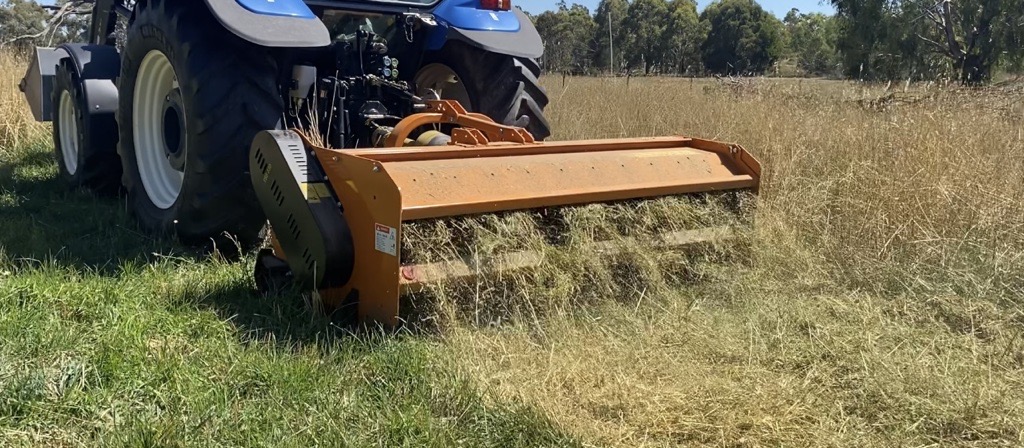Benefits of slashing and mulching
To slash or not to slash: that is the question to mulch over
Academics and experts in the grazing industry often discuss the importance of balancing fodder budgets and employing various metrics such as Kgs of green herbage mass per hectare, dry sheep equivalent (DSE) grazing days per hectare, and percentage utilisation. It is crucial for farmers to analyse their feed supply curves and align their enterprise needs with the peaks and troughs of the average feed supply.
However, even the most diligent farmer who meticulously monitors and makes evidence-based decisions can still face challenges. Factors such as rainfall variability and volatile livestock prices can disrupt feed budgets and result in under-utilised low-quality grass-dominated pastures, subsequently affecting livestock growth rates.
Slash and mulch trial demonstration
In March 2023, the demonstration trial paddock at Orange Agricultural Institute exhibited a total herbage mass of approximately 8 tonnes per hectare. Out of this, only about 2 tonnes per hectare were green, while the remaining consisted of dead stalks, leaves, and detached plant material. The density of the Phalaris grass made it difficult to see or move around the paddock.
Before introducing cattle to the paddock, two treatments were applied: slashing and mulching. Both methods involved cutting the vegetation at approximately 15 centimetres high.
- The slash treatment left a small windrow to one side, resulting in uneven residue distribution across the area.
- The mulched treatment evenly spread the residue, chopping it into smaller segments.
After the slash and mulch treatments, the Angus heifers were allowed to graze the paddock three times.
Following rainfall events, rapid regrowth of Phalaris grass was observed across all treatments. The most notable distinction among the treatments was the availability of high-quality green growth. Cattle were able to select a superior diet in the slashed and mulched treatments.
During a trial site workshop held on May 20, it was demonstrated to attending farmers the considerable amount of dry dead stalk and low-quality Phalaris stalk (roughly half) when simulating cattle grazing.
Over a span of 2.5 months, the visual difference in the amount of dead standing material was apparent when comparing the NIL treatment. The three grazing activities of the heifers contributed to trampling the Phalaris stalk into the ground, mitigating shading effects.

Analysis of slashed and mulched pasture quality
Samples of the pasture were sent to the DPI Wagga Wagga feed test laboratory for analysis. The table below illustrates minimal variation in the quality of green regrowth among the different treatments:
Sample ID | Crude Protein - NIR (%) | DOMD - NIR (%) | Calculation of Metabolizable Energy (MJ/kg DM) |
Slashed treatment, green | 26.8 | 74.0 | 12.0 |
Mulched treatment, green | 27.3 | 73.0 | 11.8 |
Control NIL Treatment, green | 27.9 | 71.0 | 11.5 |
Mulched treatment, dead residue | 4.4 | 44.0 | 5.9 |
Slash and mulch results
Based on this trial demonstration, the following ten key points should be considered when deciding to slash and mulch or use livestock to produce similar results:
- Conduct a pasture budget in early September, considering peak livestock demands during calving/lambing.
- Allocate paddocks for fodder conservation in the event of a surplus, with contingency plans if surplus herbage mass cannot be cut.
- Dry adult livestock can be used effectively to achieve similar outcomes as slashing and mulching. Monitoring the condition of this livestock class to prevent excessive weight or fat loss is vital for business success.
- Slashing and mulching should be employed as a last resort due to the associated costs of time, diesel, and machinery wear and tear.
- Ideally, slashing and mulching should be completed no later than the end of December, allowing low-quality residue time to decompose over summer.
- Mulching in late summer or early autumn may reduce sub-clover germination in productive pastures.
- In high altitude and high rainfall regions, enabling sunlight to penetrate pastures is preferable to shading caused by tall temperate grasses.
- A significant amount of dead grass residue can lead to reduced soil nitrogen levels.
- Reducing dead standing pasture enhances the effectiveness of herbicides and gibberellic acid (via droplet contact with growth points) in autumn and winter.
- Slashing and mulching treatments can substantially increase the availability of green pasture regrowth, leading to improved animal performance.
While mulching resulted in even and finely chopped residue, it is essential to consider paddock suitability. Rocks, stumps, and uneven ground can pose challenges for many mulchers.
To enhance pasture budgeting skills, Local Land Services will be conducting PROGRAZE courses in various areas. Interested individuals can contact their local livestock or pasture officer to register.
As many livestock businesses are currently experiencing decent soil moisture levels to start 2024, now is the time to assess which paddocks would be best suited to slashing or mulching. High levels of cut residue may inhibit sunlight and shade new clover plants. Therefore, knowing which paddocks you want to maximise clover germination will help you decide which paddocks are best suited to slashing right now.